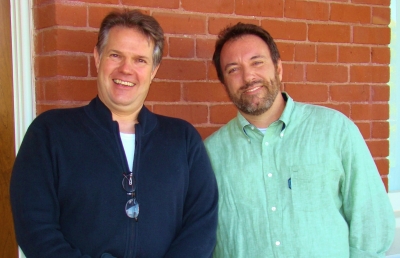In the late 1940s, Walt Disney was considering whether to continue with feature animation. The studio was deeply in debt after World War II--in fact, no Disney feature had returned a profit since Snow White and the Seven Dwarfs. The war had dried up foreign revenues for features released during the early ‘40s (Pinocchio, Fantasia, Dumbo and Bambi). Animated features, then in production, were suspended when the United States entered WW II. The military, for all intents and purposes, took over the Walt Disney Studios. Production shifted to the making of military training films and educational films for the government. These films were sold at cost as part of Walt Disney’s contribution to the war effort. With income severely restricted for so many years, the studio had fallen some $4 million in debt, with no relief in sight. The post war “package” features, such as Fun and Fancy Free, which were essentially animated shorts and live action cobbled together into a feature length movie; only broke even, at best. With the financial future of the studio unclear, Walt had to decide whether to close down feature animation, as some had advised him to do; or take a huge risk and attempt to rekindle the fire that, a decade earlier, had transformed the motion picture business forever. He decided to go ahead and make another animated feature and returned to a fairy tale, Cinderella, as the vehicle that would bring about a re-birth of Disney feature animation.
 On Sunday, April 15th, Academy Award winning director (For The Birds), Ralph Eggleston and Walt Disney Family Museum creative consultant and moderator Jeff Kurtti guided the audience on a journey back to the late 1940s to explore the cultural influences that helped to shape the look, sound and feel of Walt Disney’s classic animated feature Cinderella. This 1950 release broke new ground for the Walt Disney Studios and ushered in a second golden age of Disney animated features in the 1950s and 60s.
On Sunday, April 15th, Academy Award winning director (For The Birds), Ralph Eggleston and Walt Disney Family Museum creative consultant and moderator Jeff Kurtti guided the audience on a journey back to the late 1940s to explore the cultural influences that helped to shape the look, sound and feel of Walt Disney’s classic animated feature Cinderella. This 1950 release broke new ground for the Walt Disney Studios and ushered in a second golden age of Disney animated features in the 1950s and 60s.
To set the context for the period in which Cinderella was created, Ralph shared some popular songs and artwork that no doubt influenced the animators as they worked on Cinderella. A few bars of 12th St. Rag, The Woody Woodpecker Song andButtons and Bows were played to provide a sense of popular music at the time. The landscape artwork of Dale Nichols and Thomas Hart Benton indicated that they were a definite inspiration to the look and feel of Disney feature landscapes of the period. The album cover art of Alex Steinweiss showed that colorful abstract objects could be equally evocative of place and feeling as were realistic artistic representations. This music and artwork no doubt filled the environment surrounding Disney animators of the late 1940s. It profoundly influenced their artistic sensibilities and became manifest in their own work during this period.
To cement this point, Eggelston moved on to show concept art created by various Disney artists for Cinderella. From storyboards by Joe Rinaldi and Bill Peet to layout work by Ken Anderson and Ken O’Connor, the evolution of Cinderella’s visual design began to unfold for the Walt Disney Family Museum audience. While showing the detailed artwork for simple kitchen utensils, Eggelston recounted a comment made by Ken Anderson when asked why so much effort went into drawing simple items that would only be a brief part of the background of a scene. Anderson pointed out that the audience may not notice the items, but they would notice if they were not there. That typified the pursuit of excellence of the Disney organization.
The delightful color palate created by Mary Blair was represented by several beautiful renderings. Eggelston showed how many of her concepts for the castle and rooms within the Tremaine home appeared virtually unchanged in film. Her stylized background concepts help to create a new look for Cinderella that evoked a lush and elegant environment without the detail that might have distracted from the characters. It was evident that Blair’s style and use of color, that began to blossom during her 1941 trip with “El Grupo” to South America, was in full form as Cinderella went into production. Her unique use of color and form continued to be used in the concept art she created forAlice in Wonderland and Peter Pan. Blair was a favorite of Walt Disney and was the first female artist to break into the male dominated stable of artists at the Walt Disney Studios. The pinnacle of her work for Walt Disney appears in her whimsical designs for It’s A Small World.
Since financial resources were limited, Disney had the entire film shot in live action to assist the animators in creating the film, especially the movement of the human characters, in less time and at less expense. The live action model for Cinderella was Helene Stanley, who later served in the same function as Aurora for Sleeping Beauty.
Cinderella was the first Disney feature in which the musical score, by Oliver Wallace, was created after the animation was completed. Typically the musical score was recorded and the animation was created to fit the music. Wallace’s score was very effective in pacing the action of each scene. To demonstrate this, Eggelson showed a scene, without the score, of Cinderella running down stairs to help a trapped mouse. He then played the same scene with the musical score. It was clearly evident how the music enhanced the pace of the animation.
To add to the popular appeal of Cinderella, Walt decided to use Tin Pan Alley songwriters for the first time. He enjoyed a popular 1947 songChi-Baba Chi-Baba (My Bambino Go To Sleep). It’s songwriters, Jerry Livingston, Mack David and Al Hoffman were brought in to create a suite of songs for the film. The result of their collaboration included Academy Award nominated Bibbidi-Bobbidi-Boo and A Dream is a Wish Your Heart Makes.
In addition to the music, the voice talent had a tremendous impact on the success of Cinderella. Ilene Woods provided the voice of Cinderella. She brought a caring, yet confident quality that resonated with the new emerging perception of women in post war America. Lady Tremaine was voiced by Eleanor Audley, who brought an elegant menace to the uncaring stepmother. She went on to provide the voice of the equally menacing Maleficent in Sleeping Beauty and the disembodied Madame Leota in the Haunted Mansion at Disneyland. Eggelston showed a brief clip of Bette Davis as Regina Giddens in The Little Foxes. In 2003, the character of Regina Giddens, ranked #43 on the American Film Institute list of the 50 Best Villains of American Cinema. Eggelston pointed out that the character of Lady Tremaine was inspired by Bette Davis’ 1941 portrayal of the cold and conniving character. So the choice was highly appropriate. Another memorable voice was provided by radio veteran Verna Felton, who had earlier provided the voice of a pompous elephant in Dumbo. For Cinderella, she provided the unforgettable energetic, kind and nurturing voice of Cinderella’s fairy godmother.
Cinderella was right for its time. It was an age old story, well told in the best Disney way. It had a strong, self-sufficient heroine who made her own way to the ball rather than waiting for her prince to come. The film offered a new look in color and visual design that was in tune with the new art emerging at the time. The popular songs created by the Tin Pan Alley trio of songwriters remained at the top of the charts long after the movie’s initial release. It was a huge risk for Walt Disney. Had Cinderella not succeeded, the future of feature animation at the Walt Disney Studios would have been in jeopardy. Instead, the risk Walt took in making Cinderella paid off handsomely and not only helped preserve feature animation, but ushered in a new era of classic Disney films.
Ralph Eggleston and Jeff Kurtti provided an entertaining and insightful behind-the-scenes look at the creation of one of Walt Disney’s most beloved classics. By sharing some of the difficulties Disney had to overcome, they gave the audience an even deeper appreciation of Walt’s triumphal accomplishment in producing Cinderella.

Frank Teurlay
Volunteer at The Walt Disney Family Museum
